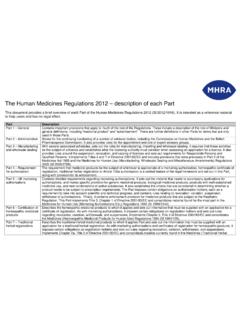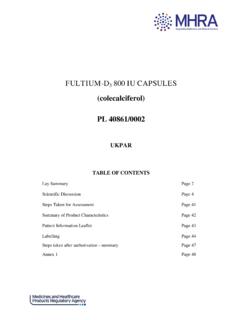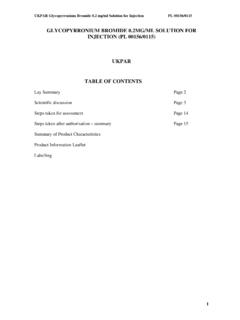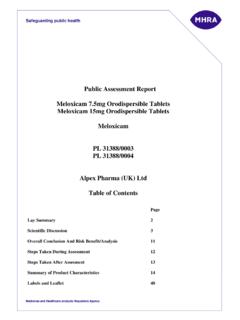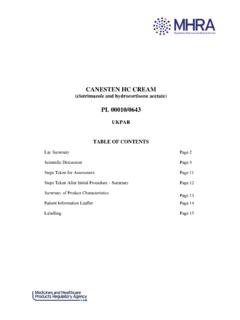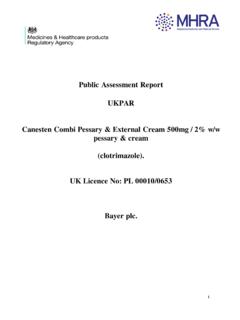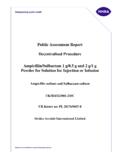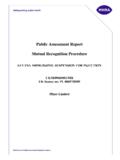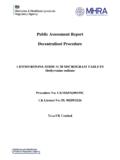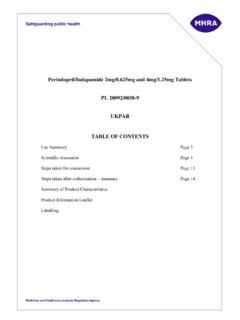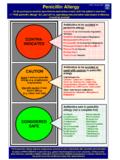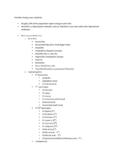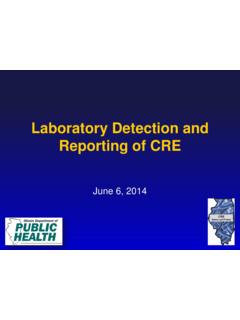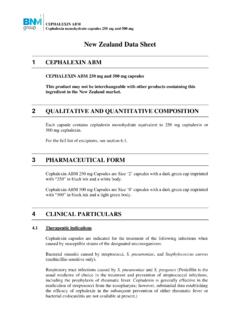Transcription of Cefixime 400 mg Film-coated Tablets, PL 22805 …
1 MHRA PAR; Cefixime 400 MG Film-coated TABLETS, PL 22805 /0032-3 1 Public Assessment Report Decentralised Procedure Cefixime 400 mg Film-coated Tablets PL 22805 /0032 PL 22805 /0033 UK/H/1532/001/DC UK/H/3965/001/DC Orchid Europe Ltd. MHRA PAR; Cefixime 400 MG Film-coated TABLETS, PL 22805 /0032-3 2 Lay summary The Medicines and Healthcare products Regulatory Agency (MHRA) granted Orchid Europe Ltd. Marketing Authorisations (licences) for the medicinal product Cefixime 400 mg Film-coated Tablets (product licence numbers: PL 22805 /0032 and PL 22805 /0033) on 16 December 2010. This medicine is available on prescription only. Cefixime belongs to a group of medicines called cephalosporins, which are used for treating infections. Cefixime 400 mg Film-coated Tablets are used to treat: Infection of the middle ear Sinus infection Throat infection Infection causing sudden worsening of long-standing bronchitis Lung infections (pneumonia) acquired outside hospital Infections in the urinary tract including some infections of the kidneys The data submitted in support of these applications for Cefixime 400 mg Film-coated Tablets raised no clinically significant safety concerns and it was, therefore, judged that the benefits of using this product outweigh the risks; hence Marketing Authorisations have been granted.
2 MHRA PAR; Cefixime 400 MG Film-coated TABLETS, PL 22805 /0032-3 3 TABLE OF CONTENTS Module 1: Information about Decentralised Procedures Page 4 Module 2: Summaries of Product Characteristics Page 5 Module 3: Product Information Leaflets Page 24 Module 4: Labelling Page 30 Module 5: Scientific Discussion Page 45 I. Introduction II. Quality aspects III. Preclinical aspects IV. Clinical aspects V. Overall conclusion and benefit-risk assessment MHRA PAR; Cefixime 400 MG Film-coated TABLETS, PL 22805 /0032-3 4 Module 1 Information about Decentralised Procedures Name of the products in the Reference Member State Cefixime 400 mg Film-coated Tablets Type of applications Generic (Article ) Name of the active substance (INN) Cefixime Pharmacotherapeutic classification (ATC code) Third-generation cephalosporins (J01DD08) Pharmaceutical form and strength Film-coated tablet, 400mg Reference number for the Decentralised Procedures UK/H/1532/001/DC UK/H/3965/001/DC Reference Member State United Kingdom Member States concerned UK/H/1532/01/DC: AT and DE UK/H/3965/01/DC: AT and IT Start of Decentralised Procedures 24 August 2009 End date of Decentralised Procedures 10 November 2010 Marketing Authorisation numbers PL 22805 /0032 PL 22805 /0033 Name and address of the authorisation holder Orchid Europe Ltd.
3 Building 3, Chiswick Park, 566 Chiswick High Road, Chiswick, London, W4 5YA, United Kingdom MHRA PAR; Cefixime 400 MG Film-coated TABLETS, PL 22805 /0032-3 5 Module 2 Summaries of Product Characteristics 1 NAME OF THE MEDICINAL PRODUCT Cefixime 400 mg Film-coated Tablets 2 QUALITATIVE AND QUANTITATIVE COMPOSITION Each Film-coated tablet contains mg Cefixime trihydrate, equivalent to 400 mg Cefixime anhydrous For a full list of excipients, see section 3 PHARMACEUTICAL FORM Film-coated tablet White to off white, Film-coated , rectangular shaped tablet having partial break line on both sides. 4 CLINICAL PARTICULARS Therapeutic indications Cefixime is indicated for the treatment of the following infections when caused by susceptible organisms (see section ): Acute exacerbations of chronic bronchitis Community-acquired Pneumonia Uncomplicated lower urinary tract infections Uncomplicated pyelonephritis In the treatment of: Otitis media Sinusitis Pharyngitis The use of Cefixime should be reserved for infections in which the causative organism is known or suspected to be resistant to other commonly used antibacterial agents or when treatment failure may carry significant risk.
4 Consideration should be given to official guidance on the appropriate use of antibacterial agents. Posology and method of administration Adults The recommended dose for adults is 400 mg daily taken as a single dose (see section and ). MHRA PAR; Cefixime 400 MG Film-coated TABLETS, PL 22805 /0032-3 6 The usual course of treatment is 7 days. This may be continued for up to 14 days if required. Elderly patients Elderly patients may be given the same dose as recommended for adults. Renal function should be assessed and dosage should be adjusted in severe renal impairment (See above and section ). Adolescents 12 years of age Adolescents 12 years of age may be given the same dose as recommended for adults. Children from 6 months to 11 years of age It is recommended that Children from 6 months to 11 years of age be given Cefixime as an oral suspension. The recommended dosage for children is 8 mg / kg body weight / day administered as a single dose or in two divided doses.
5 Children less than 6 months of age The safety and efficacy of Cefixime has not been established in children less than 6 months of age. Renal insufficiency Cefixime may be administered in the presence of impaired renal function. Normal dose and schedule may be given in patients with creatinine clearances of 20 ml/min or greater. In patients whose creatinine clearance is less than 20 ml/min, it is recommended that a dose of 200 mg once daily should not be exceeded. The dose and regimen for patients who are maintained on chronic ambulatory peritoneal dialysis or haemodialysis should follow the same recommendation as that for patients with creatinine clearances of less than 20 ml/min. There are insufficient data regarding use of Cefixime in the pediatric and adolescent age group in the presence of renal insufficiency. Therefore, the use of Cefixime in these patient-groups is not recommended. Method of administration Cefixime tablets are for oral administration only. Cefixime tablets should be taken with a sufficient amount of water.
6 Cefixime may be taken with or without food (see section ). Contraindications Hypersensitivity to Cefixime , other cephalosporin antibiotics or to any of the excipients. Previous, immediate and/or severe hypersensitivity reaction to penicillin or any beta-lactam antibiotic. MHRA PAR; Cefixime 400 MG Film-coated TABLETS, PL 22805 /0032-3 Special warnings and precautions for use Cefixime should be given with caution to patients who have shown hypersensitivity to other drugs. Cephalosporins should be given with caution to penicillin-sensitive patients, as there is some evidence of partial cross-allergenicity between the penicillins and cephalosporins. Patients have had severe reactions (including anaphylaxis) to both classes of drugs. Special care is indicated in patients who have experienced any allergic reaction to penicillins or any other beta-lactam antibiotics as cross-reactions may occur (for contraindications due to known hypersensitivity reactions see section ).
7 If severe hypersensitivity reactions or anaphylactic reactions occur after administration of Cefixime , the use of Cefixime should be discontinued immediately and appropriate emergency measures should be initiated. Renal insufficiency Cefixime should be administered with caution in patients with creatinine clearance < 20 ml / min (see sections and ). There are insufficient data regarding use of Cefixime in the pediatric and adolescent age group in the presence of renal insufficiency. Therefore, the use of Cefixime in these patient-groups is not recommended. Renal function is to be monitored under a combination therapy with Cefixime preparations and aminoglycoside antibiotics, polymyxin B, colistin or high-dose loop diuretics ( furosemide) because of the probability of additional renal impairment. This applies particularly for patients with already restricted renal function (see section ). Treatment with Cefixime at the recommended (400mg) dose can significantly alter the normal flora of the colon and lead to overgrowth of clostridia.
8 Studies indicate that a toxin produced by Clostridium difficile is a primary cause of antibiotic-associated diarrhoea. In patients who develop severe persistent diarrhoea during or after use of Cefixime , the risk of life threatening pseudomembranous colitis should be taken into account. The use of Cefixime should be discontinued and appropriate treatment measures should be established. Management of pseudomembranous colitis should include sigmoidoscopy, appropriate bacteriologic studies, fluids, electrolytes and protein supplementation. If the colitis does not improve after the drug has been discontinued, or if the symptoms are severe, oral vancomycin is the drug of choice for antibiotic-associated pseudomembranous colitis produced by C. difficile. Other causes of colitis should be excluded. The use of medicinal products inhibiting the intestinal peristalsis is contraindicated. Influence on laboratory diagnostic tests: A false positive reaction for glucose in the urine may occur with Benedict's or Fehling's solutions or with copper sulphate test tablets, but not with tests based on enzymatic glucose oxidase reactions.
9 MHRA PAR; Cefixime 400 MG Film-coated TABLETS, PL 22805 /0032-3 8 A false positive direct Coombs test has been reported during treatment with cephalosporin antibiotics, therefore it should be recognised that a positive Coombs test may be due to the drug. Interaction with other medicinal products and other forms of interaction Concomitant intake with potentially nephrotoxic substances (such as aminoglycoside antibiotics,colistin, polymyxin and viomycin) and strong-acting diuretics ( ethacrynic acid or furosemide) induce an increased risk of impairment of renal function (see section ). Nifedipine, a calcium channel blocker, may increase bioavailability of Cefixime up to 70 %. In common with other cephalosporins, increases in prothrombin time have been noted in a few patients. Care should therefore be taken in patients receiving anticoagulation therapy. Administration of Cefixime may reduce the efficacy of oral contraceptives. It is therefore recommended to take supplemental non-hormonal contraceptive measures.
10 Pregnancy and lactation Pregnancy There are no adequate data from the use of Cefixime in pregnant women. Animal studies do not indicate direct or indirect harmful effects with respect to pregnancy, embryonal/ foetal development, parturition or postnatal development (see section ). Cefixime should not be used in pregnant mothers unless considered essential by the physician. Lactation It is unknown whether Cefixime is excreted in human breast milk. Animal studies have shown excretion of Cefixime in breast milk. A decision on whether to continue/discontinue breast-feeding or to continue/discontinue therapy with Cefixime should be made taking into account the benefit of breast-feeding to the child and the benefit of Cefixime therapy to the woman. However, until further clinical experience is available, Cefixime should not be prescribed to breast-feeding mothers. Effects on ability to drive and use machines Cefixime has no known influence on the ability to drive and use machines.
